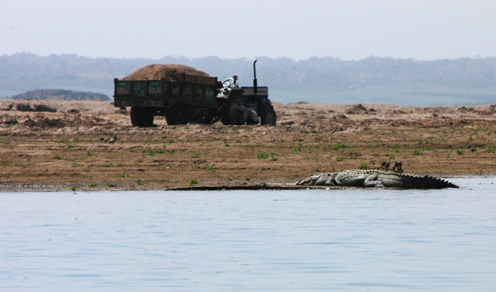The Indian Gharial: Going, Going, Gone?
(Part – II)
-Govind Singh
Two months after the shocking deaths of several Indian gharials, a critically endangered (CR) species according to the International Union for the Conservation
of Nature and Natural Resources (IUCN) in Chambal river, authorities are still unsure about what caused the sudden deaths of a large number of the Chambal alligators.
While preliminary studies were said to be carried out immediately after the reporting of the incident and samples were slated to be sent to expert
research institutes across the country, no concrete findings over the mysterious deaths have been put forward so far. And everything, from increasing pollution in the Chambal, heavy metal contamination in the river, gharials being poisoned by the local fisher
folks backed by the sand-mining mafia, spread of intestinal diseases and lung disorders are being stated to be the possible reasons for the gharial deaths. It should be noted here that only a few months back, some 40 alligators had
been released into the Chambal river. Prior to their release, these gharials were bred in captivity at the Kukrail Gharial Rehabilitation Centre (KGRC) in Lucknow.
The Chambal river, one of the last habitats of the Indian Gharial is also a hotspot for sand-mining. The Chambal region, once infamous because of its
dacoits (who came to be known as Chambal ke daaku) that operated from the forests around the river, did not face much anthropogenic pressures till the 1970s. However, post 70s, almost all the dacoit groups surrendered, and the forest and the river became
easily accessible to the locals and outsiders alike. Moreover, the constant pressure from an ever-increasing rural population around the river only added to the problem.
After being declared a sanctuary towards the end of 1970s, activities such as fishing, sand-mining, etc. were either to be carried out after taking adequate
license or were completely banned. This further brought the local people in direct conflict with not just the Forests and Wildlife Department but also with the wildlife itself. The situation today is such that all activities including fishing and sand-mining
have been reported to be taking place unchecked, in almost the entire stretch of the river.
At the same time, the Chambal River is home to other fascinating wildlife species like the crocodiles and the Gangetic Dolphins as well. Therefore, the reported illegal activities, particularly sand-mining in the area is a threat to the entire wildlife
diversity of Chambal river.

A crocodile seen on the bank of the Chambal river, with a tractor carrying out sand-mining activity in the vicinity. Image taken from a boat.
(Courtesy, Mr. Sitaram Tagore of Jiwaji University)
However, banning such activities may not be a suitable solution since a) such activities are already banned and b) the same issue of enforcement will
arise with which the concerned officials are already struggling. Moreover, the people who carry out sand-mining right from the tractor/ truck driver to the middlemen; all depend on this activity for their livelihood. Even though they only get a small share
of profits made by the reported mining mafia active in the area, presently they do not have any alternative form of earning their livelihood. Thus, unless we provide an alternative to the existing population in and around the Chambal river, neither stricter
enforcement nor banning all activities along the river will work out.
One such alternative could be eco-tourism. The changing face of Chambal has not really caught on and many North Indians (let alone the rest of
India) are unaware of what the region has to offer. Eco-tourism, the ‘responsible’ and neglected step-sister of conventional tourism is also known as nature based tourism and is actually something that
appeals to the ecologically and socially conscious individuals, for whom, travelling is not just about enjoying the scenic surroundings but also understanding the various environmental and social issues of the area, etc. An ideal ecotourism
package therefore includes programmes that evaluate environmental and cultural factors, minimize the negative aspects of conventional tourism on the environment and enhance the cultural integrity of local people. Such an ecotourism, if promoted in the region,
will not only provide tremendous employment oppourtunites to the native people but will also help initiate community based environment conservation programmes instilling a love for the wildlife in the hearts of the native people.
In addition, realizing that sand is an essential requirement to facilitate developmental activities, certain areas should be de-notified, after careful
study and allotted for legal sand-mining. This should be done only after an extremely careful ecological study of the area such that the land allotted for mining does not overlap with the habitat of either the gharial or the other wildlife species. According
to Mr. Faiyaz A. Khudsar, a wildlife biologist at the University of Delhi, not only are such studies wanting but we also lack basic information about the Indian gharial, right from its feeding habit to when and how should a gharial bred in captivity, be released
in the wild.
“What people have been doing are surveys! They surveyed and found that the Gharial feeds upon carnivorous fish! They surveyed a few gharials to decide
at what age they should release them into the wild!” complained Mr. Faiyaz. “This must stop and we need to carry out proper ecological studies to determine the habit and habitat of the Indian gharial, for as of now, the scientific community is not even sure
about the gharial’s trophic level in the food web and the ecosystem services that it exclusively provides”, he further added.
“It is neither pollution nor poison that killed the gharials. If that would have been the case, the crocodiles and the more sensitive fish and other
species would also have been affected. Since most of the gharials that have died are of the same age group, it is most likely that they were all suffering from a lungworm disease that may they may have acquired before being released into the wild.” Mr. Faiyaz
clarified.